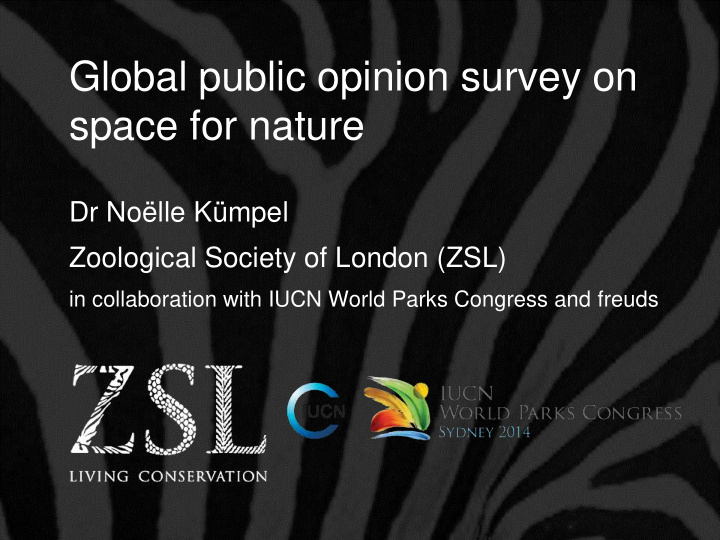



Global public opinion survey on space for nature Dr Noëlle Kümpel Zoological Society of London (ZSL) in collaboration with IUCN World Parks Congress and freuds
Background • CBD’s Aichi Target 11: to protect at least 17% of the world’s terrestrial and inland water areas and 10% of its coastal and marine areas by 2020 • Target largely agreed through a political process, but little consultation with public on what areas we should protect for nature, and why Key aspect of this survey is to ask people around the world – for the first time – their opinion regarding the space we set aside for nature
Survey methodology • Short online questionnaire (21 questions) targeting a randomised, national-level cross-section of society • 7 developed and developing countries (Australia, UK, USA, Brazil, China, India and South Africa) – all inhabited continents • A total of 7189 questionnaires completed (~1000/country) • Country samples considered representative of national population (in terms of age structure, gender, etc.) • Further responses collected via an open global online call disseminated directly by ZSL and partners, but not included here
Are protected areas necessary?
How much should be protected?
How much should be protected?
How much should be protected?
How much should be protected? Land
How much should be protected? • Females, younger people and those working outdoors >20 hours a week want more area protected • Interest in/knowledge of conservation/protected areas has no effect • People want slightly more ocean protected than land • People want more of the planet protected than their own country • People assume much more (30% for both land and sea) is already protected than in reality
Perceived barriers to increasing target
Why are protected areas necessary?
Why are PAs important to you personally? Brazil India China SA Australia UK USA Conserving wildlife and habitats Keeping planet functioning Strongly disagree 1 - Protecting wildlife 3 - Climate change mitigation Disagree 2 - Protecting natural beauty 4 - Maintaining water cycle None Connecting to nature Supporting local livelihoods Agree 5 - Wellbeing/Stress reduction 8 - Protection from disasters Strongly agree 6 - Leisure/Tourism 9 - Food and water for locals 10 - Economic benefits 7 - Cultural value
Why are PAs important to you personally? Brazil India China SA Australia UK USA Conserving wildlife and habitats Keeping planet functioning Strongly disagree 1 - Protecting wildlife 3 - Climate change mitigation Disagree 2 - Protecting natural beauty 4 - Maintaining water cycle None Connecting to nature Supporting local livelihoods Agree 5 - Wellbeing/Stress reduction 8 - Protection from disasters Strongly agree 6 - Leisure/Tourism 9 - Food and water for locals 10 - Economic benefits 7 - Cultural value
Why are PAs important to you personally? Brazil India China SA Australia UK USA Conserving wildlife and habitats Keeping planet functioning Strongly disagree 1 - Protecting wildlife 3 - Climate change mitigation Disagree 2 - Protecting natural beauty 4 - Maintaining water cycle None Connecting to nature Supporting local livelihoods Agree 5 - Wellbeing/Stress reduction 8 - Protection from disasters Strongly agree 6 - Leisure/Tourism 9 - Food and water for locals 10 - Economic benefits 7 - Cultural value
Why are PAs important to the government? Brazil India China SA Australia UK USA Conserving wildlife and habitats Keeping planet functioning Strongly disagree 1 - Protecting wildlife 3 - Climate change mitigation Disagree 2 - Protecting natural beauty 4 - Maintaining water cycle None Connecting to nature Supporting local livelihoods Agree 5 - Wellbeing/Stress reduction 8 - Protection from disasters Strongly agree 6 - Leisure/Tourism 9 - Food and water for locals 10 - Economic benefits 7 - Cultural value
Why are PAs important to the government? Brazil India China SA Australia UK USA Conserving wildlife and habitats Keeping planet functioning Strongly disagree 1 - Protecting wildlife 3 - Climate change mitigation Disagree 2 - Protecting natural beauty 4 - Maintaining water cycle None Connecting to nature Supporting local livelihoods Agree 5 - Wellbeing/Stress reduction 8 - Protection from disasters Strongly agree 6 - Leisure/Tourism 9 - Food and water for locals 10 - Economic benefits 7 - Cultural value
How often do you visit PAs?
How often do you visit PAs?
How often do you visit types of PAs?
How often do you visit types of PAs? India + Brazil Brazil
Barriers to visiting protected areas Access issues Lack of awareness Cost/resource restrictions
Summary • People want 50% of land and ocean protected – considerably more than current targets of 17% and 10% • People assume much more (30% of both land and ocean) is already protected • People think PAs are most important for conservation of wildlife and habitats – but subtle differences in other values for developing/developed countries? • Use of PAs may create more positive attitudes – but other country factors may be important • Plan to extend survey to more countries and to more people (beyond online community), to inform national policy and help us understand global patterns
Thanks to… • Jonathan Baillie • Robin Freeman • Jacob Ainscough • Sophie Grange-Chamfray • All those who piloted, fed back, distributed and completed the survey
Recommend
More recommend